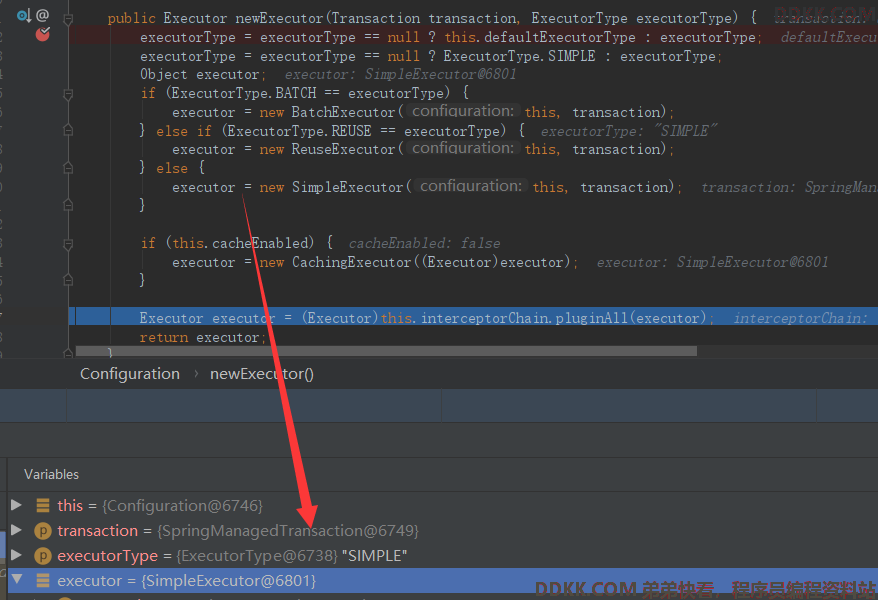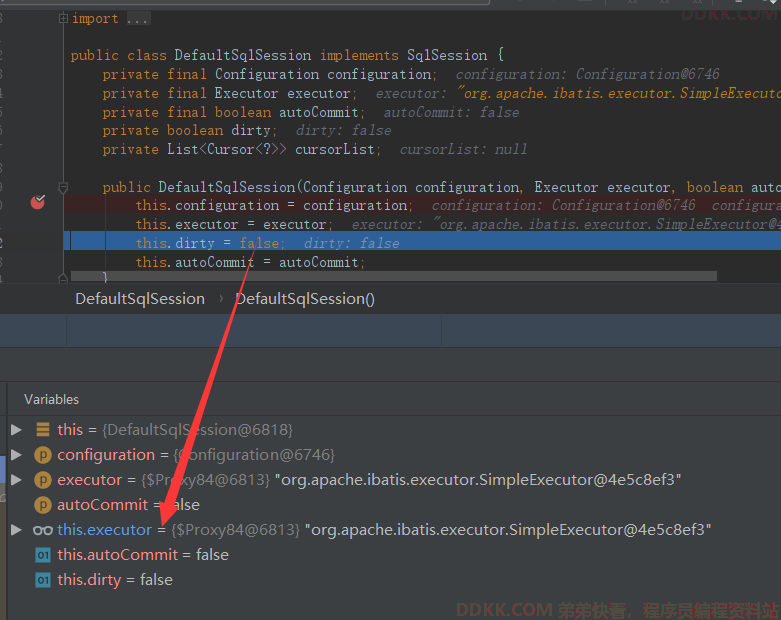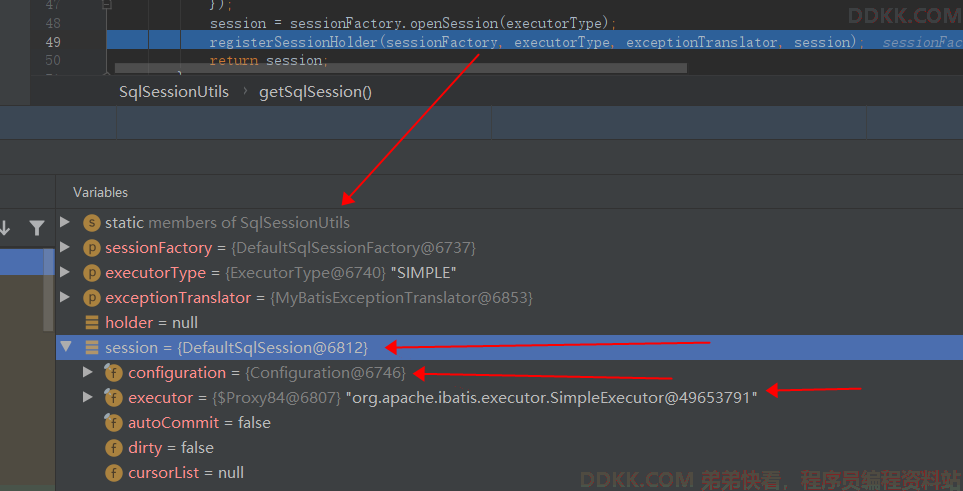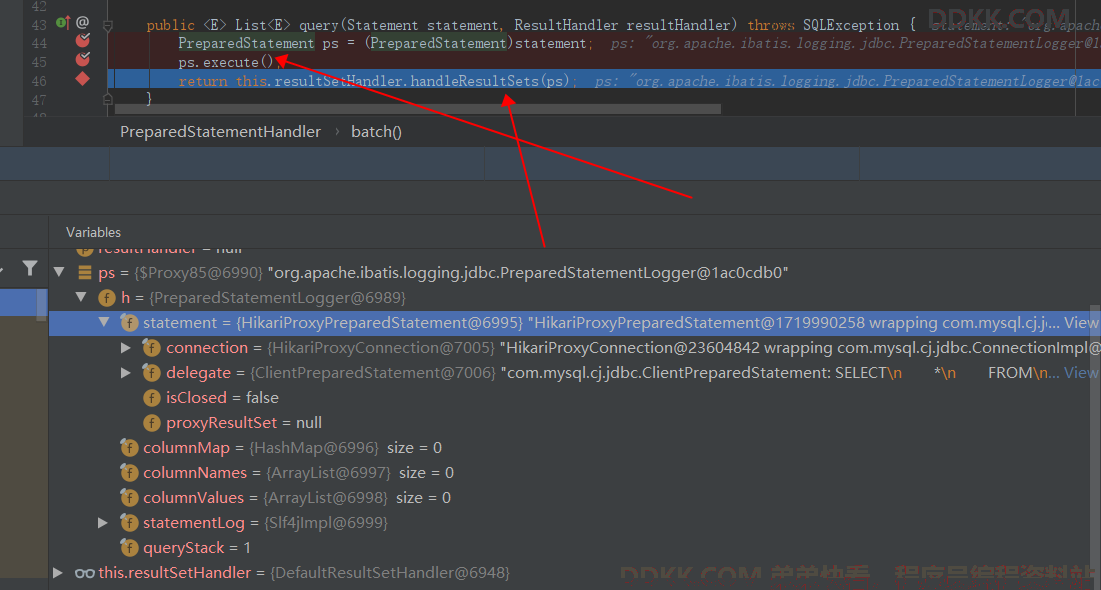16、MyBatis源码 - MyBatis四大组件之Executor源码及流程解析
简介
之前的文档提过,MyBatis有四大组件,这些核心组件,贯穿了整个MyBatis的生命周期,下面分析下源码,深入了解下他们的工作机制及功能。
- Executor:SQL执行器
- StatementHandler:Statement处理器
- ParameterHandler:参数处理器
- ResultSetHandler:结果处理器
Executor
源码
Executor接口
Executor执行器,是一个接口,位于 org.apache.ibatis.executor包下,其实现类如下:

Executor接口定义了数据库操作及事务管理的众多方法,源码如下:
/**
* @author DDKK.COM 弟弟快看,程序员编程资料站
* 执行器
*/
public interface Executor {
// 不需要ResultHandler
ResultHandler NO_RESULT_HANDLER = null;
// 更新
int update(MappedStatement ms, Object parameter) throws SQLException;
// 查询,带分页,带缓存,BoundSql
<E> List<E> query(MappedStatement ms, Object parameter, RowBounds rowBounds, ResultHandler resultHandler, CacheKey cacheKey, BoundSql boundSql) throws SQLException;
// 查询,带分页
<E> List<E> query(MappedStatement ms, Object parameter, RowBounds rowBounds, ResultHandler resultHandler) throws SQLException;
// 游标查询
<E> Cursor<E> queryCursor(MappedStatement ms, Object parameter, RowBounds rowBounds) throws SQLException;
// 刷新批处理语句
List<BatchResult> flushStatements() throws SQLException;
// 提交和回滚,参数是是否要强制
void commit(boolean required) throws SQLException;
// 事务回滚,参数是是否要强制
void rollback(boolean required) throws SQLException;
// 创建缓存的键对象
CacheKey createCacheKey(MappedStatement ms, Object parameterObject, RowBounds rowBounds, BoundSql boundSql);
// 判断是否缓存了
boolean isCached(MappedStatement ms, CacheKey key);
// 清空缓存
void clearLocalCache();
// 延迟加载
void deferLoad(MappedStatement ms, MetaObject resultObject, String property, CacheKey key, Class<?> targetType);
// 事务管理器
Transaction getTransaction();
// 关闭
void close(boolean forceRollback);
// 是否关闭
boolean isClosed();
// 包装执行器
void setExecutorWrapper(Executor executor);
}
BaseExecutor
BaseExecutor是一个抽象类,实现了Executor接口,并重写了一部分方法,比如一级缓存处理、基础查询等。
/**
* @author DDKK.COM 弟弟快看,程序员编程资料站
* 执行器基类
*/
public abstract class BaseExecutor implements Executor {
private static final Log log = LogFactory.getLog(BaseExecutor.class);
protected Transaction transaction;
protected Executor wrapper;
// 延迟加载队列(线程安全)
protected ConcurrentLinkedQueue<DeferredLoad> deferredLoads;
//本地缓存机制(Local Cache)防止循环引用(circular references)和加速重复嵌套查询(一级缓存)
//本地缓存
protected PerpetualCache localCache;
//本地输出参数缓存
protected PerpetualCache localOutputParameterCache;
protected Configuration configuration;
//查询堆栈
protected int queryStack;
private boolean closed;
protected BaseExecutor(Configuration configuration, Transaction transaction) {
this.transaction = transaction;
this.deferredLoads = new ConcurrentLinkedQueue<DeferredLoad>();
this.localCache = new PerpetualCache("LocalCache");
this.localOutputParameterCache = new PerpetualCache("LocalOutputParameterCache");
this.closed = false;
this.configuration = configuration;
this.wrapper = this;
}
@Override
public Transaction getTransaction() {
if (closed) {
throw new ExecutorException("Executor was closed.");
}
return transaction;
}
@Override
public void close(boolean forceRollback) {
try {
try {
rollback(forceRollback);
} finally {
if (transaction != null) {
transaction.close();
}
}
} catch (SQLException e) {
// Ignore. There's nothing that can be done at this point.
log.warn("Unexpected exception on closing transaction. Cause: " + e);
} finally {
transaction = null;
deferredLoads = null;
localCache = null;
localOutputParameterCache = null;
closed = true;
}
}
@Override
public boolean isClosed() {
return closed;
}
//SqlSession.update/insert/delete会调用此方法
@Override
public int update(MappedStatement ms, Object parameter) throws SQLException {
ErrorContext.instance().resource(ms.getResource()).activity("executing an update").object(ms.getId());
if (closed) {
throw new ExecutorException("Executor was closed.");
}
//先清局部缓存,再更新,如何更新交由子类,模板方法模式
clearLocalCache();
return doUpdate(ms, parameter);
}
//刷新语句,Batch用
@Override
public List<BatchResult> flushStatements() throws SQLException {
return flushStatements(false);
}
public List<BatchResult> flushStatements(boolean isRollBack) throws SQLException {
if (closed) {
throw new ExecutorException("Executor was closed.");
}
return doFlushStatements(isRollBack);
}
//SqlSession.selectList会调用此方法
@Override
public <E> List<E> query(MappedStatement ms, Object parameter, RowBounds rowBounds, ResultHandler resultHandler) throws SQLException {
//得到绑定sql
BoundSql boundSql = ms.getBoundSql(parameter);
//创建缓存Key
CacheKey key = createCacheKey(ms, parameter, rowBounds, boundSql);
//查询
return query(ms, parameter, rowBounds, resultHandler, key, boundSql);
}
@SuppressWarnings("unchecked")
@Override
public <E> List<E> query(MappedStatement ms, Object parameter, RowBounds rowBounds, ResultHandler resultHandler, CacheKey key, BoundSql boundSql) throws SQLException {
ErrorContext.instance().resource(ms.getResource()).activity("executing a query").object(ms.getId());
//如果已经关闭,报错
if (closed) {
throw new ExecutorException("Executor was closed.");
}
//先清局部缓存,再查询.但仅查询堆栈为0,才清。为了处理递归调用
if (queryStack == 0 && ms.isFlushCacheRequired()) {
clearLocalCache();
}
List<E> list;
try {
//加一,这样递归调用到上面的时候就不会再清局部缓存了
queryStack++;
//先根据cachekey从localCache去查
list = resultHandler == null ? (List<E>) localCache.getObject(key) : null;
if (list != null) {
//若查到localCache缓存,处理localOutputParameterCache
handleLocallyCachedOutputParameters(ms, key, parameter, boundSql);
} else {
//从数据库查
list = queryFromDatabase(ms, parameter, rowBounds, resultHandler, key, boundSql);
}
} finally {
//清空堆栈
queryStack--;
}
if (queryStack == 0) {
//延迟加载队列中所有元素
for (DeferredLoad deferredLoad : deferredLoads) {
deferredLoad.load();
}
// issue601
//清空延迟加载队列
deferredLoads.clear();
if (configuration.getLocalCacheScope() == LocalCacheScope.STATEMENT) {
// issue482
//如果是STATEMENT,清本地缓存
clearLocalCache();
}
}
return list;
}
@Override
public <E> Cursor<E> queryCursor(MappedStatement ms, Object parameter, RowBounds rowBounds) throws SQLException {
BoundSql boundSql = ms.getBoundSql(parameter);
return doQueryCursor(ms, parameter, rowBounds, boundSql);
}
//延迟加载,DefaultResultSetHandler.getNestedQueryMappingValue调用.属于嵌套查询,比较高级.
@Override
public void deferLoad(MappedStatement ms, MetaObject resultObject, String property, CacheKey key, Class<?> targetType) {
if (closed) {
throw new ExecutorException("Executor was closed.");
}
DeferredLoad deferredLoad = new DeferredLoad(resultObject, property, key, localCache, configuration, targetType);
//如果能加载,则立刻加载,否则加入到延迟加载队列中
if (deferredLoad.canLoad()) {
deferredLoad.load();
} else {
//这里怎么又new了一个新的,性能有点问题
deferredLoads.add(new DeferredLoad(resultObject, property, key, localCache, configuration, targetType));
}
}
//创建缓存Key
@Override
public CacheKey createCacheKey(MappedStatement ms, Object parameterObject, RowBounds rowBounds, BoundSql boundSql) {
if (closed) {
throw new ExecutorException("Executor was closed.");
}
//MyBatis 对于其 Key 的生成采取规则为:[mappedStementId + offset + limit + SQL + queryParams + environment]生成一个哈希码
CacheKey cacheKey = new CacheKey();
cacheKey.update(ms.getId());
cacheKey.update(rowBounds.getOffset());
cacheKey.update(rowBounds.getLimit());
cacheKey.update(boundSql.getSql());
List<ParameterMapping> parameterMappings = boundSql.getParameterMappings();
TypeHandlerRegistry typeHandlerRegistry = ms.getConfiguration().getTypeHandlerRegistry();
// mimic DefaultParameterHandler logic
//模仿DefaultParameterHandler的逻辑,不再重复,请参考DefaultParameterHandler
for (ParameterMapping parameterMapping : parameterMappings) {
if (parameterMapping.getMode() != ParameterMode.OUT) {
Object value;
String propertyName = parameterMapping.getProperty();
if (boundSql.hasAdditionalParameter(propertyName)) {
value = boundSql.getAdditionalParameter(propertyName);
} else if (parameterObject == null) {
value = null;
} else if (typeHandlerRegistry.hasTypeHandler(parameterObject.getClass())) {
value = parameterObject;
} else {
MetaObject metaObject = configuration.newMetaObject(parameterObject);
value = metaObject.getValue(propertyName);
}
cacheKey.update(value);
}
}
if (configuration.getEnvironment() != null) {
// issue176
cacheKey.update(configuration.getEnvironment().getId());
}
return cacheKey;
}
@Override
public boolean isCached(MappedStatement ms, CacheKey key) {
return localCache.getObject(key) != null;
}
@Override
public void commit(boolean required) throws SQLException {
if (closed) {
throw new ExecutorException("Cannot commit, transaction is already closed");
}
clearLocalCache();
flushStatements();
if (required) {
transaction.commit();
}
}
@Override
public void rollback(boolean required) throws SQLException {
if (!closed) {
try {
clearLocalCache();
flushStatements(true);
} finally {
if (required) {
transaction.rollback();
}
}
}
}
@Override
public void clearLocalCache() {
if (!closed) {
localCache.clear();
localOutputParameterCache.clear();
}
}
protected abstract int doUpdate(MappedStatement ms, Object parameter)
throws SQLException;
protected abstract List<BatchResult> doFlushStatements(boolean isRollback)
throws SQLException;
protected abstract <E> List<E> doQuery(MappedStatement ms, Object parameter, RowBounds rowBounds, ResultHandler resultHandler, BoundSql boundSql)
throws SQLException;
protected abstract <E> Cursor<E> doQueryCursor(MappedStatement ms, Object parameter, RowBounds rowBounds, BoundSql boundSql)
throws SQLException;
protected void closeStatement(Statement statement) {
if (statement != null) {
try {
statement.close();
} catch (SQLException e) {
// ignore
}
}
}
/**
* Apply a transaction timeout.
*
* @param statement a current statement
* @throws SQLException if a database access error occurs, this method is called on a closed <code>Statement</code>
* @see StatementUtil#applyTransactionTimeout(Statement, Integer, Integer)
* @since 3.4.0
*/
protected void applyTransactionTimeout(Statement statement) throws SQLException {
StatementUtil.applyTransactionTimeout(statement, statement.getQueryTimeout(), transaction.getTimeout());
}
private void handleLocallyCachedOutputParameters(MappedStatement ms, CacheKey key, Object parameter, BoundSql boundSql) {
//处理存储过程的OUT参数
if (ms.getStatementType() == StatementType.CALLABLE) {
final Object cachedParameter = localOutputParameterCache.getObject(key);
if (cachedParameter != null && parameter != null) {
final MetaObject metaCachedParameter = configuration.newMetaObject(cachedParameter);
final MetaObject metaParameter = configuration.newMetaObject(parameter);
for (ParameterMapping parameterMapping : boundSql.getParameterMappings()) {
if (parameterMapping.getMode() != ParameterMode.IN) {
final String parameterName = parameterMapping.getProperty();
final Object cachedValue = metaCachedParameter.getValue(parameterName);
metaParameter.setValue(parameterName, cachedValue);
}
}
}
}
}
//从数据库查
private <E> List<E> queryFromDatabase(MappedStatement ms, Object parameter, RowBounds rowBounds, ResultHandler resultHandler, CacheKey key, BoundSql boundSql) throws SQLException {
List<E> list;
//先向缓存中放入占位符???
localCache.putObject(key, EXECUTION_PLACEHOLDER);
try {
list = doQuery(ms, parameter, rowBounds, resultHandler, boundSql);
} finally {
//最后删除占位符
localCache.removeObject(key);
}
//加入缓存
localCache.putObject(key, list);
//如果是存储过程,OUT参数也加入缓存
if (ms.getStatementType() == StatementType.CALLABLE) {
localOutputParameterCache.putObject(key, parameter);
}
return list;
}
protected Connection getConnection(Log statementLog) throws SQLException {
Connection connection = transaction.getConnection();
if (statementLog.isDebugEnabled()) {
//如果需要打印Connection的日志,返回一个ConnectionLogger(代理模式, AOP思想)
return ConnectionLogger.newInstance(connection, statementLog, queryStack);
} else {
return connection;
}
}
@Override
public void setExecutorWrapper(Executor wrapper) {
this.wrapper = wrapper;
}
//延迟加载
private static class DeferredLoad {
private final MetaObject resultObject;
private final String property;
private final Class<?> targetType;
private final CacheKey key;
private final PerpetualCache localCache;
private final ObjectFactory objectFactory;
private final ResultExtractor resultExtractor;
// issue781
public DeferredLoad(MetaObject resultObject,
String property,
CacheKey key,
PerpetualCache localCache,
Configuration configuration,
Class<?> targetType) {
this.resultObject = resultObject;
this.property = property;
this.key = key;
this.localCache = localCache;
this.objectFactory = configuration.getObjectFactory();
this.resultExtractor = new ResultExtractor(configuration, objectFactory);
this.targetType = targetType;
}
public boolean canLoad() {
//缓存中找到,且不为占位符,代表可以加载
return localCache.getObject(key) != null && localCache.getObject(key) != EXECUTION_PLACEHOLDER;
}
//加载
public void load() {
@SuppressWarnings("unchecked")
// we suppose we get back a List
List<Object> list = (List<Object>) localCache.getObject(key);
//调用ResultExtractor.extractObjectFromList
Object value = resultExtractor.extractObjectFromList(list, targetType);
resultObject.setValue(property, value);
}
}
}
SimpleExecutor类
之前我们分析过,全局配置中,可以自定义执行器的类型。
mybatis:
执行器类型
executor-type: simple
mybatis提供了枚举类ExecutorType来配置执行器类型。
public enum ExecutorType {
SIMPLE,
REUSE,
BATCH;
private ExecutorType() {
}
}
SimpleExecutor就是默认的简单执行器,继承自BaseExecutor抽象类,并重写了doUpdate、doQuery、doQueryCursor、doFlushStatements方法。SimpleExecutor执行器,每执行一次 update 或 select,就开启一个 Statement 对象,用完就直接关闭 Statement了对象。
/**
* @author DDKK.COM 弟弟快看,程序员编程资料站
* 简单执行器
*/
public class SimpleExecutor extends BaseExecutor {
public SimpleExecutor(Configuration configuration, Transaction transaction) {
super(configuration, transaction);
}
// update
@Override
public int doUpdate(MappedStatement ms, Object parameter) throws SQLException {
// java.sql.Statement
Statement stmt = null;
try {
Configuration configuration = ms.getConfiguration();
// 新建一个StatementHandler
StatementHandler handler = configuration.newStatementHandler(this, ms, parameter, RowBounds.DEFAULT, null, null);
// 准备语句
stmt = prepareStatement(handler, ms.getStatementLog());
// StatementHandler.update
return handler.update(stmt);
} finally {
closeStatement(stmt);
}
}
// select
@Override
public <E> List<E> doQuery(MappedStatement ms, Object parameter, RowBounds rowBounds, ResultHandler resultHandler, BoundSql boundSql) throws SQLException {
Statement stmt = null;
try {
Configuration configuration = ms.getConfiguration();
StatementHandler handler = configuration.newStatementHandler(wrapper, ms, parameter, rowBounds, resultHandler, boundSql);
stmt = prepareStatement(handler, ms.getStatementLog());
return handler.<E>query(stmt, resultHandler);
} finally {
closeStatement(stmt);
}
}
@Override
protected <E> Cursor<E> doQueryCursor(MappedStatement ms, Object parameter, RowBounds rowBounds, BoundSql boundSql) throws SQLException {
Configuration configuration = ms.getConfiguration();
StatementHandler handler = configuration.newStatementHandler(wrapper, ms, parameter, rowBounds, null, boundSql);
Statement stmt = prepareStatement(handler, ms.getStatementLog());
return handler.<E>queryCursor(stmt);
}
@Override
public List<BatchResult> doFlushStatements(boolean isRollback) throws SQLException {
return Collections.emptyList();
}
// 准备语句
private Statement prepareStatement(StatementHandler handler, Log statementLog) throws SQLException {
Statement stmt;
Connection connection = getConnection(statementLog);
// 调用StatementHandler.prepare
stmt = handler.prepare(connection, transaction.getTimeout());
// 调用StatementHandler.parameterize
handler.parameterize(stmt);
return stmt;
}
}
ReuseExecutor类
ReuseExecutor,可重用的执行器,也是继承自BaseExecutor抽象类。
这里的重用指的是重复使用 Statement,它会在内部使用一个 Map 把创建的 Statement 都缓存起来,每次执行 SQL 命令的时候,都会去判断是否存在基于该 SQL 的 Statement 对象,如果存在 Statement 对象并且对应的 connection 还没有关闭的情况下就继续使用之前的 Statement 对象,并将其缓存起来。每个SqlSession 都有一个新的 Executor 对象,所以我们缓存在 ReuseExecutor 上的Statement 作用域是同一个 SqlSession。
/**
* @author DDKK.COM 弟弟快看,程序员编程资料站
* 可重用的执行器
*/
public class ReuseExecutor extends BaseExecutor {
// 可重用的执行器内部用了一个map,用来缓存SQL语句对应的Statement
private final Map<String, Statement> statementMap = new HashMap<String, Statement>();
public ReuseExecutor(Configuration configuration, Transaction transaction) {
super(configuration, transaction);
}
@Override
public int doUpdate(MappedStatement ms, Object parameter) throws SQLException {
Configuration configuration = ms.getConfiguration();
// 和SimpleExecutor一样,新建一个StatementHandler
StatementHandler handler = configuration.newStatementHandler(this, ms, parameter, RowBounds.DEFAULT, null, null);
// 准备语句
Statement stmt = prepareStatement(handler, ms.getStatementLog());
return handler.update(stmt);
}
@Override
public <E> List<E> doQuery(MappedStatement ms, Object parameter, RowBounds rowBounds, ResultHandler resultHandler, BoundSql boundSql) throws SQLException {
Configuration configuration = ms.getConfiguration();
StatementHandler handler = configuration.newStatementHandler(wrapper, ms, parameter, rowBounds, resultHandler, boundSql);
Statement stmt = prepareStatement(handler, ms.getStatementLog());
return handler.<E>query(stmt, resultHandler);
}
@Override
protected <E> Cursor<E> doQueryCursor(MappedStatement ms, Object parameter, RowBounds rowBounds, BoundSql boundSql) throws SQLException {
Configuration configuration = ms.getConfiguration();
StatementHandler handler = configuration.newStatementHandler(wrapper, ms, parameter, rowBounds, null, boundSql);
Statement stmt = prepareStatement(handler, ms.getStatementLog());
return handler.<E>queryCursor(stmt);
}
@Override
public List<BatchResult> doFlushStatements(boolean isRollback) throws SQLException {
for (Statement stmt : statementMap.values()) {
closeStatement(stmt);
}
statementMap.clear();
return Collections.emptyList();
}
private Statement prepareStatement(StatementHandler handler, Log statementLog) throws SQLException {
Statement stmt;
// 得到绑定的SQL语句
BoundSql boundSql = handler.getBoundSql();
// 如果缓存中已经有了,直接得到Statement
String sql = boundSql.getSql();
if (hasStatementFor(sql)) {
stmt = getStatement(sql);
applyTransactionTimeout(stmt);
} else {
// 如果缓存没有找到,则和SimpleExecutor处理完全一样,然后加入缓存
Connection connection = getConnection(statementLog);
stmt = handler.prepare(connection, transaction.getTimeout());
putStatement(sql, stmt);
}
handler.parameterize(stmt);
return stmt;
}
private boolean hasStatementFor(String sql) {
try {
return statementMap.keySet().contains(sql) && !statementMap.get(sql).getConnection().isClosed();
} catch (SQLException e) {
return false;
}
}
private Statement getStatement(String s) {
return statementMap.get(s);
}
private void putStatement(String sql, Statement stmt) {
statementMap.put(sql, stmt);
}
}
BatchExecutor类
BatchExecutor,批处理执行器,主要是用于做批量更新操作的 ,底层会调用Statement的 executeBatch()方法实现批量操作。
/**
* @author DDKK.COM 弟弟快看,程序员编程资料站
* 批量处理执行器
*/
public class BatchExecutor extends BaseExecutor {
public static final int BATCH_UPDATE_RETURN_VALUE = Integer.MIN_VALUE + 1002;
// Statement集合
private final List<Statement> statementList = new ArrayList<Statement>();
// batch结果集合
private final List<BatchResult> batchResultList = new ArrayList<BatchResult>();
private String currentSql;
private MappedStatement currentStatement;
public BatchExecutor(Configuration configuration, Transaction transaction) {
super(configuration, transaction);
}
@Override
public int doUpdate(MappedStatement ms, Object parameterObject) throws SQLException {
// 获得配置信息
final Configuration configuration = ms.getConfiguration();
// 获得StatementHandler
final StatementHandler handler = configuration.newStatementHandler(this, ms, parameterObject, RowBounds.DEFAULT, null, null);
// 获得Sql语句
final BoundSql boundSql = handler.getBoundSql();
final String sql = boundSql.getSql();
final Statement stmt;
// 如果sql语句等于当前sql MappedStatement 等于当前Map碰到Statement
if (sql.equals(currentSql) && ms.equals(currentStatement)) {
int last = statementList.size() - 1;
// 获得最后一个
stmt = statementList.get(last);
applyTransactionTimeout(stmt);
handler.parameterize(stmt);//fix Issues 322
BatchResult batchResult = batchResultList.get(last);
batchResult.addParameterObject(parameterObject);
} else {
// 如果不存在就创建一个批处理操作
Connection connection = getConnection(ms.getStatementLog());
stmt = handler.prepare(connection, transaction.getTimeout());
handler.parameterize(stmt); //fix Issues 322
currentSql = sql;
currentStatement = ms;
// 添加批量处理操作
statementList.add(stmt);
batchResultList.add(new BatchResult(ms, sql, parameterObject));
}
// 最终是调用jdbc的批处理操作
handler.batch(stmt);
return BATCH_UPDATE_RETURN_VALUE;
}
@Override
public <E> List<E> doQuery(MappedStatement ms, Object parameterObject, RowBounds rowBounds, ResultHandler resultHandler, BoundSql boundSql)
throws SQLException {
Statement stmt = null;
try {
flushStatements();
Configuration configuration = ms.getConfiguration();
StatementHandler handler = configuration.newStatementHandler(wrapper, ms, parameterObject, rowBounds, resultHandler, boundSql);
Connection connection = getConnection(ms.getStatementLog());
stmt = handler.prepare(connection, transaction.getTimeout());
handler.parameterize(stmt);
return handler.<E>query(stmt, resultHandler);
} finally {
closeStatement(stmt);
}
}
@Override
protected <E> Cursor<E> doQueryCursor(MappedStatement ms, Object parameter, RowBounds rowBounds, BoundSql boundSql) throws SQLException {
flushStatements();
Configuration configuration = ms.getConfiguration();
StatementHandler handler = configuration.newStatementHandler(wrapper, ms, parameter, rowBounds, null, boundSql);
Connection connection = getConnection(ms.getStatementLog());
Statement stmt = handler.prepare(connection, transaction.getTimeout());
handler.parameterize(stmt);
return handler.<E>queryCursor(stmt);
}
// 刷新Statement,记录执行次数
@Override
public List<BatchResult> doFlushStatements(boolean isRollback) throws SQLException {
try {
List<BatchResult> results = new ArrayList<BatchResult>();
if (isRollback) {
return Collections.emptyList();
}
for (int i = 0, n = statementList.size(); i < n; i++) {
Statement stmt = statementList.get(i);
applyTransactionTimeout(stmt);
// 记录批量处理执行操作的条数
BatchResult batchResult = batchResultList.get(i);
try {
batchResult.setUpdateCounts(stmt.executeBatch());
MappedStatement ms = batchResult.getMappedStatement();
// 参数对象集合
List<Object> parameterObjects = batchResult.getParameterObjects();
KeyGenerator keyGenerator = ms.getKeyGenerator();
if (Jdbc3KeyGenerator.class.equals(keyGenerator.getClass())) {
Jdbc3KeyGenerator jdbc3KeyGenerator = (Jdbc3KeyGenerator) keyGenerator;
jdbc3KeyGenerator.processBatch(ms, stmt, parameterObjects);
} else if (!NoKeyGenerator.class.equals(keyGenerator.getClass())) {
//issue141
for (Object parameter : parameterObjects) {
keyGenerator.processAfter(this, ms, stmt, parameter);
}
}
// Close statement to close cursor1109
closeStatement(stmt);
} catch (BatchUpdateException e) {
StringBuilder message = new StringBuilder();
message.append(batchResult.getMappedStatement().getId())
.append(" (batch index")
.append(i + 1)
.append(")")
.append(" failed.");
if (i > 0) {
message.append(" ")
.append(i)
.append(" prior sub executor(s) completed successfully, but will be rolled back.");
}
throw new BatchExecutorException(message.toString(), e, results, batchResult);
}
// 记录操作
results.add(batchResult);
}
return results;
} finally {
for (Statement stmt : statementList) {
closeStatement(stmt);
}
currentSql = null;
statementList.clear();
batchResultList.clear();
}
}
}
CachingExecutor类
CachingExecutor,缓存执行器,主要是处理二级缓存,当开启了二级缓存配置后,上面的执行器,就被包装为CachingExecutor,默认的数据库查询工作,还是由CachingExecutor中的delegate(实际的执行器)进行操作。
/**
* @author DDKK.COM 弟弟快看,程序员编程资料站
* @author Eduardo Macarron
* 二级缓存执行器
*/
public class CachingExecutor implements Executor {
private final Executor delegate;
private final TransactionalCacheManager tcm = new TransactionalCacheManager();
// 包装一个执行器
public CachingExecutor(Executor delegate) {
this.delegate = delegate;
delegate.setExecutorWrapper(this);
}
@Override
public Transaction getTransaction() {
return delegate.getTransaction();
}
@Override
public void close(boolean forceRollback) {
try {
//issues499,524 and573
if (forceRollback) {
tcm.rollback();
} else {
tcm.commit();
}
} finally {
delegate.close(forceRollback);
}
}
@Override
public boolean isClosed() {
return delegate.isClosed();
}
@Override
public int update(MappedStatement ms, Object parameterObject) throws SQLException {
// 刷新缓存完再update
flushCacheIfRequired(ms);
return delegate.update(ms, parameterObject);
}
@Override
public <E> List<E> query(MappedStatement ms, Object parameterObject, RowBounds rowBounds, ResultHandler resultHandler) throws SQLException {
BoundSql boundSql = ms.getBoundSql(parameterObject);
// query时传入一个缓存key参数
CacheKey key = createCacheKey(ms, parameterObject, rowBounds, boundSql);
return query(ms, parameterObject, rowBounds, resultHandler, key, boundSql);
}
@Override
public <E> Cursor<E> queryCursor(MappedStatement ms, Object parameter, RowBounds rowBounds) throws SQLException {
flushCacheIfRequired(ms);
return delegate.queryCursor(ms, parameter, rowBounds);
}
@Override
public <E> List<E> query(MappedStatement ms, Object parameterObject, RowBounds rowBounds, ResultHandler resultHandler, CacheKey key, BoundSql boundSql)
throws SQLException {
Cache cache = ms.getCache();
// 默认情况下是没有开启缓存的(二级缓存).要开启二级缓存,你需要在你的 SQL 映射文件中添加一行: <cache/>
// 简单的说,就是先查CacheKey,查不到再委托给实际的执行器去查
if (cache != null) {
flushCacheIfRequired(ms);
if (ms.isUseCache() && resultHandler == null) {
ensureNoOutParams(ms, boundSql);
@SuppressWarnings("unchecked")
List<E> list = (List<E>) tcm.getObject(cache, key);
if (list == null) {
list = delegate.<E>query(ms, parameterObject, rowBounds, resultHandler, key, boundSql);
tcm.putObject(cache, key, list); // issue578 and116
}
return list;
}
}
return delegate.<E>query(ms, parameterObject, rowBounds, resultHandler, key, boundSql);
}
@Override
public List<BatchResult> flushStatements() throws SQLException {
return delegate.flushStatements();
}
@Override
public void commit(boolean required) throws SQLException {
delegate.commit(required);
tcm.commit();
}
@Override
public void rollback(boolean required) throws SQLException {
try {
delegate.rollback(required);
} finally {
if (required) {
tcm.rollback();
}
}
}
private void ensureNoOutParams(MappedStatement ms, BoundSql boundSql) {
if (ms.getStatementType() == StatementType.CALLABLE) {
for (ParameterMapping parameterMapping : boundSql.getParameterMappings()) {
if (parameterMapping.getMode() != ParameterMode.IN) {
throw new ExecutorException("Caching stored procedures with OUT params is not supported. Please configure useCache=false in " + ms.getId() + " statement.");
}
}
}
}
@Override
public CacheKey createCacheKey(MappedStatement ms, Object parameterObject, RowBounds rowBounds, BoundSql boundSql) {
return delegate.createCacheKey(ms, parameterObject, rowBounds, boundSql);
}
@Override
public boolean isCached(MappedStatement ms, CacheKey key) {
return delegate.isCached(ms, key);
}
@Override
public void deferLoad(MappedStatement ms, MetaObject resultObject, String property, CacheKey key, Class<?> targetType) {
delegate.deferLoad(ms, resultObject, property, key, targetType);
}
@Override
public void clearLocalCache() {
delegate.clearLocalCache();
}
private void flushCacheIfRequired(MappedStatement ms) {
Cache cache = ms.getCache();
if (cache != null && ms.isFlushCacheRequired()) {
tcm.clear(cache);
}
}
@Override
public void setExecutorWrapper(Executor executor) {
throw new UnsupportedOperationException("This method should not be called");
}
}
创建及执行流程分析
之前分析SQL执行流程,简单分析过执行器创建及执行流程,下面详细分析以下,执行器何时创建及执行操作。
环境:spring boot , 关闭二级缓存。
执行代码:
@Test
void contextLoads() {
UserQuery userQuery = new UserQuery();
userQuery.setLoginName("zhangwei");
List<User> dynamicUserList = userMapper.selectDynamicUserList(userQuery);
System.out.println(dynamicUserList);
}
1. 创建执行器
使用了spring后,SqlSessionFactory及MapperProxy就交给容器去创建和管理了,这里不深究。
断点进入下面的代码:
List<User> dynamicUserList = userMapper.selectDynamicUserList(userQuery)
首先Mapper代理对象,开始获取SqlSession,此时会执行创建执行器逻辑。调用Configuration对象的newExecutor方法,传入事务管理器及配置的执行器类型。
Executor executor = this.configuration.newExecutor(tx, execType);
然后根据配置,生成不同类型的执行器,因为关闭了缓存,所有这里默认生成的是SimpleExecutor。

根据配置,生成执行器后,有个很重要的步骤,会循环所有拦截器链中的所有拦截器,每个拦截器都会对当前当前执行器进行代理包装。
Executor executor = (Executor)this.interceptorChain.pluginAll(executor);
可以看到插件包装后,返回的执行器就包含了插件信息,具体的代理包装细节,会在插件原理介绍。

最后获取了执行器后,会将当前执行器赋值给SqlSession对象。

2. 执行器执行流程
SqlSession对象创建完成后,就获取到了当前执行器及Configuration对象,接下来就要执行SQL查询操作了。

SqlSession的查询会调用SimpleExecutor的doQuery方法。

doQuery方法会创建StatementHandler对象,StatementHandler又会解析为Statement对象,最后调用对应类型的StatementHandler的query方法进行操作。

最后使用PreparedStatement的execute方法,调用底层JDBC执行数据库操作,获取到结果集后,使用结果处理器进行返回数据处理,这里涉及到其他组件,后续会详细介绍。

总结
通过对源码和流程Debug分析,我们可以了解到:
- Executor在获取SqlSession是会根据不同的环境创建
- 创建的时候会使用插件对其进行包装
- SqlSession执行方法,实际调用的是Executor中的方法
- Executor方法中又包含了其他的组件进行协同处理
- 最后还是调用的JDBC中的方法进行数据库操作